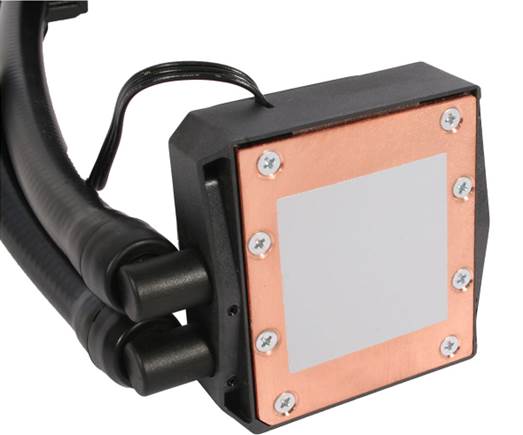Corsair’s upgraded coolers redefine
high-end CPU cooling
[+] Liquid gold: Outstanding cooling; low
noise; easy installation; great software control
[-] Liquidation: A bit pricey
Corsair H80i
How much?
·
Price: $156
·
Manufacturer: ww.corsair.com

Corsair
H80i
In detail
·
Compatibility Intel: LGA1156, LGA1155, LGA2011,
LGA1366
·
AMD: Socket FM1, FM2, AM3+, AM3, AM2+, AM2
·
Weight: 1.05kg [with fans]
·
Size [mm]: 120 x 38 x 152 [W x D x H] [radiator]
·
Fan: 2 x 120mm
·
Stated noise: 37.68dBA
Corsair H100i
How much?
·
Price: $137
·
Manufacturer: ww.corsair.com

Corsair
H100i
In detail
·
Compatibility Intel: LGA1156, LGA1155, LGA2011,
LGA1366
·
AMD: Socket FM1, FM2, AM3+, AM3, AM2+, AM2
·
Weight 1.01kg [with fans]
·
Size [mm] 120 x 27 x 275 [W x D x H] [radiator]
·
Fan 2 x 120mm
·
Stated noise 37.68dBA
We’ll waste no time and H100i are both
excellent coolers, thanks to a host of sensible upgrade decisions from Corsair.
From a basic design standpoint, they’re essentially the same pump, radiator and
dual fan combo as the H80 and H100 that they respectively replace, but with
some improvements.
The build quality is superb, with a solid
baseplate block, and the new rubber tubing is sturdy but equally flexible. The
fans have also been upgraded, and the pair of black and grey fans you’ll find
in each box are now based on Corsair’s new, quieter SP – 120 models.
Corsair’s Link software is also a good
selling point. Thanks to a USB header connection, you can monitor system
temperatures, fully and independently control fan speeds and even create your
own cooling curves. You can even alter the colors of the RGB LED on the new CPU
block, which has an attractive glossy finish.
Magnetic mounting plates makes installation
even easier than before, and thermal paste is already applied. The AMD plate
hooks and tightens onto the standard retention bracket, while Intel sockets
[other than LGA2011] require a backplate with standoff screws, onto which the
mounting plate is fastened with four screws. Finally, mounting the radiator of
either cooler is as simple as installing a fan or two.
Cooling
We tested the two coolers at three pre-set
fan profiles: Maximum, Balanced and Quiet. On Maximum, they kick up a hefty
racket, but Balanced provides an immediate and pleasing reduction in noise output,
and the Quiet profile is appropriately named too.
With a delta T of 310C, the
H100i on Maximum knocked 50C from the previous record of 360C
in our LGA1155 rig. Even better, on Quiet, it kept our CPU cooled to a delta T
of 340C – 20C lower than both the H80 and H100 on full
speed, which is phenomenal.
The H80i managed 340C on Maximum here,
another great result, and beat the H80 on comparable speed settings each time
too. On Quiet, its delta T of 400C is almost on a par with many
low-noise air cookers too.
Cooling improvements in our LGA2011 rig
were less drastic but nevertheless impressive. The H100i took up to 20C
off the comparable H100 results at each speed, and its Maximum delta T of 440C
gave it the best result we’re seen again. Given how quiet it is in Quiet mode,
no other cooler even comes close to its noise vs performance ratio.
Meanwhile, the H 80i matched or trumped the
H80 in each test too. It does begin to struggle with this toasty system on its
Quiet profile, but its delta T of 560C here is still better than
most air coolers, especially for its low noise level.
The H100i put in an outstanding performance
yet again in our AMD rig too, taking a whopping 60C from the
previous best delta T we’ve seen on Maximum. Likewise, the H80i shed between 40C
and 70C of the delta T result the H80 at all three speeds. Although its Quiet
result of 530C was much improved over the louder H80, it still wasn’t enough to
match premium air coolers such as the Thermaltake Frio Extreme or Be Quiet!
Dark Rock Pro 2.
Corsair recommends installing the coolers
as intakes, but we tested the H80i as an exhaust, and the delta T increased by
only 10C compared to an intake.
Conclusion
Both the H80i and H100i have been given
noticeable improvements in terms of cooling, noise and features and for just $8
and $15 respectively over the older models. They’re both excellent coolers, and
would make a valuable addition to any rig that isn’t already water-cooled.

Both
coolers feature a solid copper baseplate
The H80i offers a better bang per buck
ratio than the h100i for LGA1155 systems, but in hot-running LGA2011 and AMD
AM3+ systems, the H100i has the advantage, particularly at lower noise levels,
and is therefore worth the extra investment if you have a case that can
accommodate it. If not, however, the H80i is still a powerful and worthwhile
choice.

With
the USB header connection, you can monitor temperatures, control fan speeds and
create your own cooling curves
|
Corsair H80i
§ Scores:
LGa1155
§ Cooling:
38/40
§ Design:
27/30
§ Value:
25/30
§ Fitting:
Good
§ Scores:
LGa2011
§ Cooling:
35/40
§ Design:
29/30
§ Value:
27/30
§ Fitting:
Good
§ Scores:
Socket AM3+
§ Cooling:
37/40
§ Design:
28/30
§ Value:
25/30
§ Fitting:
Good
|
Corsair H100i
§ Scores:
LGa1155
§ Cooling:
39/40
§ Design:
26/30
§ Value:
21/30
§ Fitting:
Good
§ Scores:
LGa2011
§ Cooling:
39/40
§ Design:
28/30
§ Value:
26/30
§ Fitting:
Good
§ Scores:
Socket AM3+
§ Cooling:
39/40
§ Design:
27/30
§ Value:
25/30
§ Fitting:
Good
|